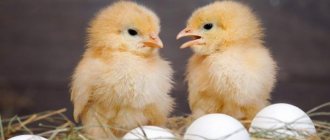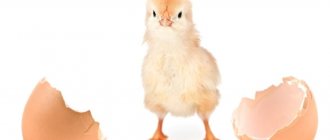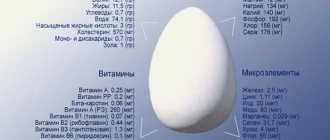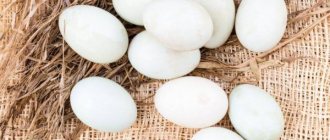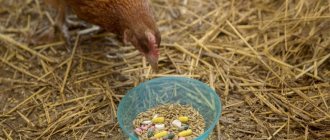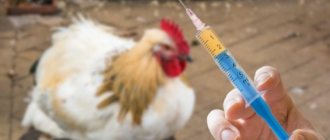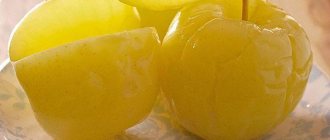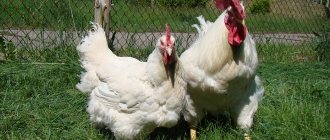Benefits of eggs
The shell of guinea fowl eggs contains 26 useful elements. The main one is easily digestible calcium. It is of organic origin and therefore is almost 100% absorbed by the human body, which cannot be said about synthetic calcium tablets. The presence of beneficial vitamins in the shell directly depends on the bird’s diet.
If she eats well, then the shells of her eggs will be dense and full of useful microelements.
The shell will be useful for older people. Their problems of brittle bones, aching bodies, hair loss and unhealthy skin are due to lack of calcium. Medicinal powder from the shell will help normalize the situation. However, it is necessary to remember about breaks between courses. Because excess calcium will lead to negative consequences for the body.
The product is considered hypoallergenic. But before use, you need to make sure that all the constituent elements are tolerable.
Protein, like the shell, is easily absorbed by the human body and is useful for people with heart and vascular diseases, diabetes, and atherosclerosis. Because the amount of cholesterol in the white of guinea fowl eggs is minimal.
Using guinea fowl eggs
The product can be eaten at any time of the day; it is believed that the optimal daily dose, which will cover the need for protein and support the general condition of the body, is 2 pieces. As mentioned above, guinea fowl eggs can be consumed raw, they can also be boiled, fried, baked, all kinds of sauces are prepared from them, and added to various dishes. Guinea fowl eggs are also used in cosmetology.
Use in cooking
Cooking guinea fowl eggs does not require any special knowledge. They are boiled a little longer than chicken ones due to the thickness of the shell. So, to get a soft-boiled egg, you need to boil it for 6 minutes, and for a hard-boiled egg it will take 12 minutes.
Soft-boiled eggs are better absorbed by the body!
Guinea fowl eggs go well with other products, so they can be used as an addition to various dishes, added to salads and snacks, omelettes, baked goods, and also as a filling for sandwiches.
A simple and healthy guinea fowl egg sandwich
Ingredients:
- baguette;
- lettuce leaves;
- celery stalks;
- guinea fowl egg;
- greens to taste.
The amount of ingredients directly depends on the number of sandwiches!
Preparation:
- The baguette is cut into thin slices, browned in a frying pan without oil;
- The guinea fowl egg is boiled for 10-12 minutes;
- Place a leaf of lettuce, a stalk of celery and a circle of egg on the bread;
- Decorate with greens.
Application in cosmetology
The beneficial properties of guinea fowl eggs have not left them aside from cosmetology. Based on this miracle product, masks, creams and shampoos are prepared that do not cause allergies and have a healing effect.
A fairly popular facial scrub is made from the shells of guinea fowl eggs. The shells are crushed to a powder and mixed with your favorite cleanser. This scrub will not only improve the condition of the skin, but also change its appearance.
This product is not recommended for use on the delicate skin around the eyes!
The product is also used as part of a hair mask. To prepare the mask, take 2 eggs and mix them with water. Apply to hair and leave for half an hour. Then wash off with cold water. The mask has a strengthening effect.
Chemical composition
The energy value of guinea fowl eggs is higher than that of eggs of other types of poultry. Because they contain less water, and the content of vitamins A and C is 1.5 times higher than that of chicken and quail eggs. But it also contains beneficial nutrients and natural amino acids.
This dietary product contains: fluorine, manganese, phosphorus, iron, silicon, copper, zinc, molybdenum, sulfur.
Therefore, the UN Food Commission emphasized the benefits of guinea fowl eggs and their chemical composition, adding them to the list of beneficial foods for humans. In addition, they are low-calorie products - only 45 kcal per 100 g.
Vitamin A
- helps strengthen bones and nails in children;
- used for the treatment and prevention of oncology, as it is a powerful antioxidant;
- Retinol reproduces cell membranes, resulting in the production of collagen. This is why vitamin A is so beneficial for the skin;
- has a positive effect on the reproductive system as it participates in the production of sex hormones.
Vitamin E
- enhances the effect of retinol;
- helps absorb vitamin A and protects it from destruction by oxygen;
- slows down aging;
- stops the appearance of age spots;
- participates in the production of collagen and elastane;
- normalizes blood clotting;
- strengthens capillary walls;
- supports nervous system and muscle health.
Vitamin D
- important for calcium absorption;
- Participates in the formation and development of bone tissue.
100 g of product contains: 12.7 g of proteins, 0.6 g of fat, 0.6 g of carbohydrates, 1 g of ash, 65 g of water.
Benefits of hard shell
The shells of royal bird embryos are used as a source of organic calcium. In powder form, it is easily absorbed by the digestive tract, giving the body the building material it needs.
The food supplement should be prepared from the dense shells of the embryo (the shell and the dense film underneath) boiled in boiling water. To emphasize its beneficial properties, after grinding the powder is moistened with natural apple or grape vinegar, turning it into a dense “dough”.
Lumps remaining after the liquid has dried are thoroughly kneaded. The finished composition is placed in a hermetically sealed glass jar, 1 g is taken daily. The recovery course is carried out for a month, after which a break of at least 3 weeks should follow.
The reaction of the shell with vinegar is accompanied by hissing and the release of carbon dioxide bubbles. It must be carried out in an open container.
Effect on diseases
Regular consumption of guinea fowl eggs has a positive effect on the entire human body. And if a person has one of the following diseases, then they will be doubly useful:
- Avitaminosis.
- Nervous system disorders.
- Gastrointestinal diseases.
- Vision problems.
- Iron-deficiency anemia.
For children, this product serves as a prevention of rickets, and for adults, osteoporosis. They are useful to use during exhaustion, loss of strength, recovery after surgery, severe stress, and sleep problems.
Benefit
In addition to the rich vitamin and mineral composition, the beneficial properties of the product cannot be underestimated. Guinea eggs:
- They are a preventive measure for diseases of the cardiovascular system, as they contain large quantities of easily digestible protein, which strengthens the walls of blood vessels.
- Useful for constant stress and depressive disorders, as well as for mental work, as they contain vitamins and microelements that help strengthen the nervous system and activate brain function.
- Hypoallergenic. Thanks to their balanced composition, they do not cause allergic reactions in the body, therefore they are recommended for consumption by people suffering from egg intolerance.
- Have a positive effect on the health of a pregnant woman. This is due to the vitamin and mineral composition that supports the pregnant woman’s body during this difficult period. Also indicated for nursing mothers.
- Replenish the lack of vitamins. Therefore, they are recommended for people suffering from vitamin deficiency.
- Reduce blood cholesterol levels. Regular consumption of these eggs reduces bad cholesterol levels.
- Indicated for patients during the postoperative period, as they help restore immunity and strengthen the body.
- Recommended for inclusion in children's diets.
Possible harm and who should not use it
If you are intolerant to the constituent elements of guinea fowl eggs, you should stop eating them. And there are also a number of cases when it will be superfluous in the diet of:
- newborns, because their intestinal microflora is not formed;
- children on vaccination days, because the body is stressed and weakened. This means an allergic reaction may be caused;
- women who have had a caesarean section;
- people after abdominal surgery;
- people with kidney disease;
- people with chronic liver diseases.
To start eating guinea fowl eggs in food, you must first consult with your doctor. Then, if the answer is positive, introduce it into your diet gradually.
People with intolerance to the components of this product should refrain from using it. Otherwise, an allergic reaction will occur. Also, their excessive use in food can negatively affect the kidneys and liver.
The vitamins contained in a cesarine egg are beneficial for both the expectant mother and the child in the womb.
Due to their low fat content and hypoallergenicity, they can be consumed by children and nursing women.
Daily consumption rate
Guinea fowl eggs can be eaten at any time of the day. The optimal dose for a healthy adult is two pieces per day. For young children, consumption per day is reduced to one piece.
There are also special protein diets for athletes, when the number of eggs consumed per day is increased according to the required diet.
This product can be eaten not only cooked, but also raw in the same quantity, especially since in this case its value increases significantly.
In general, guinea fowl eggs are a rare product that has very few competitors in terms of its chemical composition and energy value. By eating it every day, you can restore and maintain health, increase vitality and improve your appearance.
How to choose fresh guinea eggs
Even at the stage of selecting eggs for incubation, a number of checks are carried out to identify unsuitable ones. Eggs with a shelf life of up to a week, weighing at least 40 g, regular pear-shaped, light or dark brown in color and with a strong shell are considered suitable. And strength is checked by tapping two units against each other.
If there are small cracks, a rattling sound will be produced, indicating that the product is unsuitable.
The quality of guinea fowl eggs is closely related to the bird's nutrition. If there is no way to verify the naturalness of the product, then it is better to contact individual breeders. They will cost more, but can be much more useful than store-bought ones.
What do guinea fowl eggs look like?
From 80 to 120 eggs are produced per year from one individual. Productivity is low, the price of the product is quite high. Eggs have the following characteristics:
- weight – 40–48 g;
- shape – pear-shaped;
- the shell is thick, rough, may have small spots;
- color – yellowish-brown.
The size of guinea fowl eggs is slightly smaller than usual. The shape is teardrop-shaped, reminiscent of a small pear. Their properties, benefits and harms differ significantly from other types.
Recommended reading: What are the benefits of pears?
Storing eggs at home
Thanks to the strong and thick shell, this type of product is not afraid of transportation. For the same reason, their shelf life reaches up to six months.
If you store guinea fowl eggs at a temperature of 0 to 10 degrees, their shelf life can last up to 6 months. If stored at a temperature of 15 to 18 degrees – two months maximum. It is possible to store them even in the car, but no more than 28 days. For this reason, hunters, fishermen and truckers prefer to eat them on forays.
During prolonged storage, the egg white dries out and the yolk remains.
You can extend the shelf life in the following ways:
- grease the shell with melted fat or paraffin;
- place in a cardboard box with the blunt end up;
- sprinkle grain or salt on top;
- store the box in the cellar at a maximum temperature of 15 degrees.
How to select and store guinea fowl eggs
They are drop-shaped and small in size. Their color range does not go beyond yellow-brown tones. The shell is more dense. Often has small spots. For storage, the most useful are the refrigerator (up to +10 °C), pantry, and cellar. At room temperature, the product should be packaged in a cardboard box with:
- sawdust;
- paper;
- dry sand;
- salt;
- ash.
Sometimes frozen raw or hard-boiled. Valuable properties and benefits are preserved.
How to cook properly
The shell of guinea fowl eggs is thicker than chicken eggs, so they need to be cooked longer. If you need a half-baked dish, then 5-6 minutes of cooking will be enough.
If you cook them in the form of “poached”, then such a breakfast will have a beneficial effect on the gastrointestinal tract and prevent constipation.
Guinea fowl eggs, like chicken eggs, are added to any salads and dishes, or can be eaten on their own. It takes 10 minutes to hard-boil them, and 4 minutes to soft-boil them. Two eggs a day are enough to meet your daily protein requirement.
You can make your own healthy and medicinal powder from the shell. First, the eggs are boiled, cooled and shelled. Then the shells are boiled separately a couple of times for 5 minutes and set out to dry. Next, the dry shells will be finely ground and the resulting powder should be consumed daily in the amount of one teaspoon. The main thing is not to forget to drink water. One course lasts 2-3 weeks and is repeated 2 times a year.
How to cook and boil guinea fowl eggs
It is preferable to cook at minimal thermal load. This will preserve the valuable unique properties and benefits of the product. The following options are suitable:
- soft-boiled;
- poached eggs;
- omelette;
- other.
Can be used in baking, making desserts and sauces. There is more useful yolk than usual. It tastes sweet, ideal for making eggnog. Poached eggs are very easy to prepare. The result is a neat white package, which is seasoned with olive oil, lemon juice, and herbs. The nutritional properties of such a dish are healthy and varied.
Attention! Wash before use so as not to lose the useful protective layer on the shell.
Recipe examples
Below are two recipes for dishes based on guinea fowl eggs.
Stuffed eggs
Ingredients:
- guinea fowl eggs – 5 pcs;
- canned pink salmon - ½ can;
- red caviar – 1 tbsp. spoon;
- mayonnaise – 30 g;
- green onions, dill, nutmeg - to taste.
Preparation procedure:
- Boil guinea fowl eggs hard.
- Cut them in half and remove the yolks.
- Combine the yolks, pink salmon, caviar, herbs, nuts and mix into a single mixture, adding mayonnaise.
- Place the resulting pulp into the cut egg whites.
Nutritious salad
Ingredients:
- guinea fowl eggs – 5 pcs.
- potatoes – 800 g.
- olives (pitted) – 1 can.
- anchovies - 1 jar.
- sugar – 1 tsp.
- lettuce leaves – 200 g.
- olive oil – 200 ml.
- white wine vinegar – 1 tbsp.
- mild mustard – 1 tbsp.
- grain mustard – 1 tbsp.
- salt and pepper - to taste.
Preparation procedure:
- In one container you need to mix: guinea eggs, anchovies, vinegar, sugar, mustard, olive oil.
- Beat the mixture with a blender until the emulsion is homogeneous.
- Add salt and pepper and grain mustard.
- In a second bowl, mix boiled and chopped potatoes and olives.
- Pour the previously prepared mixture over the potatoes and olives.
- Place the salad in a beautiful plate and garnish with salad leaves.
- Place ¼ boiled eggs on the sides.
Use in cosmetic compositions
Excess delicacy in the household can be easily disposed of, creating luxury hair and skin care products.
- Masks made from yolk with the addition of oatmeal normalize the function of the sebaceous glands, relieving the facial skin of an unpleasant oily sheen. To achieve the desired effect, leave the mixture for a quarter of an hour, then rinse off.
- Compositions with the addition of “live” yogurt and drops of vitamin E from pharmacy ampoules restore youth and elasticity to the skin. The product is kept on the face under cling film for 60 minutes, then removed with warm water.
- Hair cosmetics are prepared by supplementing the base ingredient with grated onions and burdock oil. Masks are washed off with cool water. To turn the liquid into conditioner, it is enough to acidify it with lemon juice or vinegar.
Eggs have the ability to fully cleanse the skin and hair. Additional detergents are not required when carrying out procedures involving them.
Use in cosmetology
Homemade egg masks are effective. They are suitable for any skin type. After regular use of such masks, oily shine and blackheads on the face disappear. The skin becomes elastic and velvety.
The simplest recipe for a guinea fowl egg mask is as follows: beat the whites until thick foam (10-15 minutes depending on the speed of the blender). This mask is applied to a cleansed face for twenty minutes and then washed off.
Healthy! It is recommended to wash and rinse off masks with cool water. It does not dry out the skin the way hot water does. After washing, it is useful to apply moisturizer.
For dry skin type, the mask will consist of: 1 tsp. honey, 1 yolk, 2 drops of orange oil. And for oily skin types - from one yolk and ½ tsp. lemon juice.
The yolk of guinea fowl eggs is good for hair. Thanks to the lecithin it contains, the scalp will be saturated with vitamins, which will have a beneficial effect on hair thickness and growth. It should be applied in a thin layer to the scalp as a mask.
You need to apply masks to your hair half an hour (sometimes an hour depending on the type of mask) before washing your hair, and not after. And if you put on a plastic bag, the mask will be absorbed much better.
To restore hair, a mask is made based on: 1 yolk, 1 tbsp. nourishing balm, 1 tbsp. almond oil, 5 drops of tea tree oil. This mixture should be kept for an hour and applied only to the length of the hair, but not to the roots.
To strengthen your hair, a mask of: one egg, 1 tbsp. chopped green onions, 1 tbsp. honey
One unit of the product can wash your hair, thereby replacing shampoo. You just need to wash it off with warm water so that it doesn’t curl. By doing this procedure once every 1-2 weeks, you can get rid of oiliness and dandruff.
Guinea fowl eggs are also used for body cosmetology. An effective mask for any part of the body consists of: one egg, 100 g of yogurt and a few drops of vitamin E. After applying to problem areas, it is recommended to wrap the mask on top with cling film. If you add oatmeal to such a mask, you get a mask and a scrub (2in1). And when you need to wash it off, oatmeal will “remove” the dead skin.
What guinea fowls look like and how they differ from other birds (with photo)
In their appearance and exterior, guinea fowl differ sharply from all other types of farm poultry. Their characteristic feature is the speckled color of the plumage, a small head and unfeathered upper part of the neck, dense fleshy earrings, a hard horny comb with a bony base, and a membranous purple vocal sac under the throat. The high, thin metatarsus of guinea fowl are not feathered and do not have spurs. Especially when describing guinea fowl, it is worth noting their slate-gray color, often with light spots. Guinea fowl have no sex differences in the structure and color of their plumage. Individual parts of the body are called the same as in chickens.
Look what guinea fowl look like in these photos:
Birds are capable of flight and fast, long running. Adult domestic guinea fowl fly relatively rarely, but young ones at 1-1.5 months. - very easily and willingly. The skin of guinea fowl is quite thin, slightly pigmented, and dark-colored muscles containing a large amount of myoglobin are visible through it. For these reasons, plucked carcasses of gray and blue guinea fowl are always much darker than chicken carcasses. When heated, the carcasses immediately lighten and the breast muscles become white.
The average live weight of adult guinea fowl varies depending on gender, age, plumage color, and also on their habitat. On average, one-year-old females weigh about 1.8 kg, and males - 1.5 kg.
These photos show domestic guinea fowl of both sexes:
At first, young guinea fowls look like other poultry: the growth of guinea fowls up to 5 months of age is almost no different from the growth of Leghorn chickens. After this period, the picture changes. In about 2-3 months. Before the start of oviposition, the growth of guinea fowls is differentiated depending on the sex of the birds. Males almost stop growing; subsequently their live weight sometimes decreases. At this time, females grow with the same intensity, and by the beginning of oviposition, their growth rate even increases slightly. Thus, the average live weight of females in certain periods of life (May-October) is 10-25% higher than the average live weight of males. Subsequently, the weight and fatness of the females decreases, and after the completion of oviposition, during the molting period, they sometimes again become lighter than the males.
One of the features of young guinea fowls is their “craving for the collective.” Unlike young guinea fowl, chicks from about the 3-5th day of life become especially active, and while chicks move randomly in all directions, guinea fowl chicks move large groups in one direction.
As can be seen in the photo of guinea fowl, a noticeable exterior difference between adult males and females during the breeding season is the distance between the ends of the pubic bones (egg production measurements):
By the beginning of oviposition, the pubic bones of females become flexible and their ends diverge quite widely, so that 3-4 fingers can easily fit between them. The volume of the abdomen increases sharply. After the cessation of laying, the ends of the females' pubic bones come closer together again.
What else is worth noting when describing adult guinea fowl birds is their “individualism.” Unlike other farm birds, it is almost impossible to train guinea fowl to use individual nests, much less control nests. When kept for walking, they arrange one or more “collective nests”, where all the females of a given herd lay eggs. Typically, such a “nest” is a small depression in the ground in a walking area, in bushes, under a canopy or on the litter in a house.
Oviposition usually begins at 9-10 am and reaches a maximum at 1-2 pm. Since all birds regularly lay eggs in their favorite place, by evening a large pile of eggs forms there. The birds behave very aggressively at this time, hissing and trying to peck the bird collecting eggs.
In guinea fowl, there are clearly pronounced fluctuations in egg weight, depending on their age and date of laying. The maximum egg mass is observed in two-year-old birds, the minimum in pullets. Guinea fowl lay their largest eggs in late May - August.
These photos show the eggs of guinea fowl birds:
Guinea fowls, when kept in large groups, do not show a noticeable tendency to incubate. Every day at certain hours the birds visit their “collective nests”. As a rule, females do not sit on eggs for long, even if the nest is in a secluded place. In some females, in June-July, you can find so-called “roost spots,” i.e., areas of skin bare of feathers on the lower surface of the body, very hot to the touch. The daily collection of eggs laid between 9 a.m. and 5 p.m. does not allow birds to realize their natural instinct. The level of egg production in June-July is maximum, so there is no reason to think that there are a large number of individuals among guinea fowls who are inclined to incubate. If individual specimens with such properties appear in a herd of guinea fowl, they should be culled.
Use for weight loss
Guinea fowl eggs also have a beneficial effect on human body weight. If you add them to the diet of someone losing weight, then thanks to the satiety and low-calorie content of this product, the weight will begin to return to normal. And the protein composition will improve muscle tone. Thanks to the vitamin composition, the metabolism of fats in the liver and the ability to respond to insulin will improve, which will also have a positive effect on the figure.
Guinea fowl eggs are a rare but extremely useful product. The natural components and trace elements contained in this product are used in various fields: from food and nutrition to cosmetics.
Sailors, archaeologists and polar explorers use guinea fowl eggs as the main food for long trips. Because they have a long shelf life and are durable during transportation. Their nutritional value and beneficial composition are also advantages. And such natural products, unfortunately, are becoming fewer and fewer from year to year.
Harm
A guinea fowl egg, despite its apparent benefits to the body, can also cause harm. Rare contraindications include:
- Diseases of the liver and kidneys, acute or chronic. However, here we are talking about the daily consumption of eggs; they can be included in the diet of such patients after consultation with a doctor.
- Post-vaccination period. It is not recommended to give eggs to children if they have recently been vaccinated, as the product may cause unwanted reactions from weakened immune systems.
What's the use?
Even in the Middle Ages, the beneficial qualities of guinea fowl eggs were noticed, especially the fact that they can be stored for a long time. That is why sailors, when going on a long voyage, and travelers on a trip, do not stock up on chicken eggs, but take guinea fowl eggs. In addition, due to the thick shell, there is less risk of them accidentally fighting.
In practice, it has been established that guinea fowl eggs do not spoil and do not lose their beneficial qualities if stored at a temperature of plus ten degrees for no more than six months.
The thick shell and small number of pores significantly prevent the evaporation of moisture and become a reliable obstacle to various microorganisms.
The main beneficial qualities of eggs:
- vitamin A is 1.5 times more than in regular chicken;
- complete absence of allergenic substances;
- it is allowed and even recommended to be consumed raw;
- relatively large and appetizing yolk;
- the presence of useful substances such as carotenoids, necessary to strengthen the immune system and improve vision.
